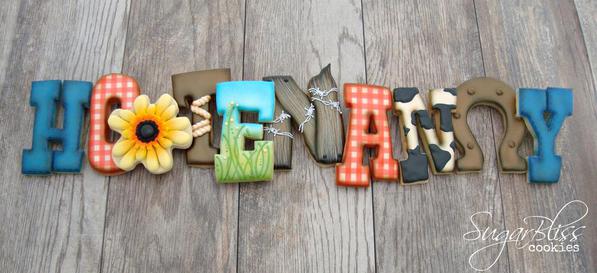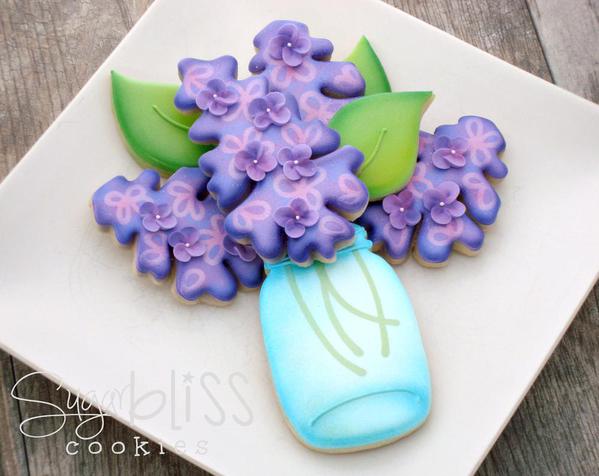Next up in our CookieCon Speakers Series: Jeanette Durham and Laurie Thompson, the dynamic sister duo behind SugarBliss Cookies, renowned for their expert use of the airbrush!
We live-chatted with these ladies a few weeks ago (transcript here), and the conversation naturally turned to . . . yes, you guessed it – airbrushing! We discovered that Jeanette and Laurie still work with the Pegasus single-action airbrush they first bought five years ago; that they aren’t likely to invest in a fancier airbrush any time soon; and that one should start with the lowlights (darker colors) when airbrushing, and then proceed to highlights. To understand all the whys and wherefores behind these airbrushing declarations, please check out the chat transcript, because today we’re focusing on the business aspects of SugarBliss and Jeanette and Laurie’s involvement in CookieCon!
![]()
JMU: Hi, ladies! I barely scratched the surface with you during our brief chat, so I’m glad to have you back for some follow-up interrogation! ![]() This Close-up is a first for me, because I’ve never interviewed two cookiers at once. I thought we’d work it tag team-style, with you taking turns answering my questions. Though if you have a difference of opinion or find a question particularly compelling, please don’t hesitate to both chime in with separate answers.
This Close-up is a first for me, because I’ve never interviewed two cookiers at once. I thought we’d work it tag team-style, with you taking turns answering my questions. Though if you have a difference of opinion or find a question particularly compelling, please don’t hesitate to both chime in with separate answers.
So, I know you’ve been working together as “SugarBliss Cookies” since 2009, but I don’t know much about the structure of your business. You mentioned you were both registered nurses as well, so do you operate SugarBliss Cookies on a full-time or part-time basis? How much time is spent cookie-ing versus nursing versus raising your young families? Roughly how many cookies do you produce per week, and how many are airbrushed? (Sorry, I just had to throw in at least one airbrushing question! ![]() )
)
![]()
JD: The balance is hard to find. We have had times where cookies have been a full-time business plus some, and others where we have cut back and restricted the number of orders we take to keep it to more of a part-time gig. We both love designing and creating cookies, so it is easy to let the business get out of control and take over. We will typically dedicate two days of the week to cookies, but sometimes it can be more. When we schedule time to work, we don’t feel deprived of our creative outlet, and the workload stays more manageable. Sometimes it is so hard to say no, but having a schedule and routine helps us keep it all in check. Our families are still very young and busy, and we made the decision that our families and kids must come first.
Some weeks we can take on more cookies than others, but it seems like a typical week would be about three to four dozen cookies. That being said, we just finished a huge order for a dance studio and produced over 200 cookies in the two days we worked.
![]()
JMU: And where do you operate your cookie business? Out of one of your homes? In a commercial facility? What factors led you to choose the space in which you work?
![]()
LT: We have a "cottage" license and operate our business out of my home. I have a second kitchen that was not being used, so it made sense to turn that into our SugarBliss kitchen. We love having a separate space for the cookie mess that doesn't interfere with my family's kitchen.
![]()
JMU: Yeah, a separate kitchen helps a bunch - my husband hates it when our personal kitchen gets overrun with cookies! How much of your cookie time is spent designing and producing cookies for sale versus teaching cookie decorating, or doing other cookie-related activities? In other words, what’s your business mix? And how do the two of you typically divvy up tasks, if you do? Do you tend to specialize in any way, or do you both share all types of tasks equally?
![]()
JD: We have been teaching two classes each month. Those two weeks we typically don’t take any orders because of all the prep work involved in the classes. The other two weeks of the month are usually the times we fit in a few orders. Designing is something that is always going on, it seems - either in planning for future classes or working on orders that are coming up.
We usually take a few minutes to discuss our plan of attack for each order. Sometimes it is faster to have one of us outline and the other flood, and other times it is faster for both of us to tackle completely different cookies. We share the tasks pretty equally. Each of us is equally capable, but there are definitely things that each of us prefers. I love to airbrush, and Laurie loves anything wet on wet – especially polka dots!
![]()
JMU: Food service is one of the toughest businesses around . . . the vast majority of restaurants, for instance, don’t make it to their fifth birthday. So to what do you attribute the longevity of your cookie business?
![]()
LT: Because we work out of my home, we are able to keep our overhead low. This allows us the flexibility to take orders when our schedules allow. We also think that producing a good looking cookie that tastes great is key to the success of our business.
![]()
JMU: What have been the biggest triumphs for you during your five years in business? the biggest challenges?
![]()
JD: Our business triumphs are more like our own little personal milestones. Neither one of us ever imagined that we would be making cookies for a living or owning our own business. I would say our biggest triumph has been developing and progressing as artists. We have been at this long enough that I feel like we have finally discovered our own style. Yet, design has also been our biggest challenge over the last five years. New designs are always a little nerve-racking, but I finally feel like we can approach new designs with a certain level of confidence, knowing what we like and don’t like, and what has worked well for us in the past.
![]()
JMU: Are there any mistakes that you made in the early years that you wouldn’t want anyone else starting out to repeat? (I’m asking for the benefit of those contemplating the launch from hobby to business.)
![]()
LT: I think the biggest mistake we made was being afraid to turn down an order. We were so eager to grow our business that we accepted every order that came our way. As a result, we were always busy with cookies and did not have time for our families. We now try to keep a healthier balance and limit the number of orders we do each week.
![]()
JMU: In our chat, you mentioned lots of benefits of working in partnership together – i.e., two heads are better than one when designing; Laurie doesn’t sweat the small stuff and keeps your process time-efficient; Jeanette likes to be adventurous with designs and try new things . . . but does being sisters in a business partnership present any unique advantages, or disadvantages?
![]()
JD: I guess I see it the same way as being in business with a best friend. We are alike in so many ways, but also very different in a few. Some days, we see a design or an approach completely differently, and it takes some time and discussion to come to some sort of compromise. Other days, one of us will inspire the other. I think we all go through creative highs and lows. The benefit of having two of us is that one of us can carry the other through the low times.
![]()
JMU: You also mentioned that you recently started teaching cookie decorating classes at Orson Gygi (a kitchen supply store in Salt Lake City). How did that opportunity come about? Did you pitch the idea to them or vice versa? How are those classes typically structured (i.e., one day vs. multiple days, hands-on vs. demo, beginner vs. advanced), and why did you settle on that structure?
![]()
LT: We met the General Manager of Orson Gygi at CookieCon and learned that they were interested in offering cookie decorating classes at their store. We had been thinking about teaching classes and were excited to work with them. We started teaching at Orson Gygi last summer and enjoy sharing our love of cookie decorating.
Each class has a set of cookies based on a holiday/theme for that month. Our classes are hands-on and typically last about three hours. In that time, we practice basic piping skills and teach the students, step-by-step, how to decorate their sets of cookies. We try to structure each class with a variety of techniques to meet the needs of beginners and returning students.
![]()
JMU: Do you both teach each class, or do you take turns teaching classes (one instructor at a time)? Why have you chosen this approach?
![]()
JD: We both team-teach all of the classes together. Like I mentioned before, we are both pretty equally capable, but we each have different techniques or details that we enjoy. We usually divide up the teaching based on the particular design or technique we are teaching in class that month. We take turns teaching while the other is circulating around helping those who need a little extra one-on-one attention or a close-up view of what we are teaching.
![]()
JMU: Teaching is certainly fun and emotionally rewarding, but – like decorating cookies for sale – it can be extremely time intensive, at least in my experience. Can you explain to our readers what typically goes into preparing for a class at Orson Gygi – i.e., how much time is spent doing what types of things?
![]()
LT: We start preparing for a class by designing a set of cookies. Sometimes this is our most time-consuming part, because it can be tricky to create a set of cookies that can be completed in under three hours yet still be challenging for our students. Once the design is done, we decorate a few example sets to take to class. Next, we bake all of the cookies our students will be decorating and make and color the royal icing we will use in class. On class day, it can take up to two hours to set up everything for our students. And finally, there is clean-up. Yes, teaching can be very time intensive, but we love it!
![]()
JMU: Pricing is the perennial question with decorated cookies, but I think it applies to teaching cookie decorating as well. How do you go about setting fees for your classes – both the price that students pay and what you receive from Orson Gygi – that are attractive to all parties involved?
![]()
JD: The fees for our classes were set in cooperation with Orson Gygi. The price for each class is very reasonable at $65. Orson Gygi provides all of the tools and equipment, and we provide the cookies and frosting. The students receive three hours of hands-on instruction, and everything they need for class is provided for them. We love teaching there! Everyone at Orson Gygi has been very helpful and great to work with.
Teaching requires a lot of prep work (and clean-up!), and we could not do it without their help. Orson Gygi’s kitchen is beautiful and spacious, which allows us to accommodate 12 students in each class. It is also very convenient for the students to be able to walk out of class and pick up all the tools, cookie cutters, and ingredients they need to create their own cookie masterpieces at home.
There are a lot of cookie decorators offering classes nowadays. Everyone has different resources available to them. Setting prices for classes can be as tricky as pricing for cookies. There is a lot of behind-the-scenes prep work and planning that most people outside the cookie world don't recognize. Because our classes are only three hours long, we have the cookies pre-baked and the frosting pre-made, colored, bottled/bagged, and all ready to go. Depending on your class size, teaching can also require a huge financial investment in acquiring enough supplies. We try to keep our cookie sets in class on the simple side, but, even still, each student uses about five to six decorating tips, bags, and bottles during class. It adds up quickly!
I would encourage everyone who teaches to make sure they are not only charging enough to cover ingredients and supplies, but also charging adequately for their time. We have had students after each class come and tell us that they had no idea how much was involved in this type of cookie decorating. There will always be people out there who don't appreciate what goes into this art - both teaching it and creating it to sell. Whether you are selling cookies or teaching classes, at the end of the day, you have to be happy with what you're doing and see your time as well spent.
![]()
JMU: I hear more and more cookiers talking about getting into teaching. What are your top three dos for those who want to teach cookie decorating? And your top three don’ts?
![]()
LT: Everyone’s class situation will be unique. The dos and don’ts will depend on how your classes are structured and the amount of class time you have. Here are some dos and don’ts that we have found in our situation:
- Remember to keep your designs somewhat simple. We have found that our students want to leave class with a set of cookies that look just like the example set we decorate beforehand. Our students have been happier with the easier designs and leave class feeling like a success!
- Incorporate as much hands-on instruction as possible during class. It is what the students come for! And it is what makes your classes different than an online tutorial - hands-on experience gives them the opportunity to ask questions as they work and encounter different challenges.
- Mix it up! We try to make each class unique with different techniques and challenges for the students. We have students who like to come to every class we teach. The variety keeps them interested and also helps them develop a wide range of skills.
- Don’t overload your teaching plan. Allow time for questions and individualized help if some students need it. We feel like we are sometimes moving through instruction and material so quickly during class. It can be a lot to take in – especially for students who are first-time decorators.
- Don’t take on more than you can chew. Jeanette and I teach 12 students together, but the thought of teaching that many alone is completely overwhelming. We mentioned before how one of us will teach while the other is circulating, helping each individual and answering questions. If you’re teaching alone, allow some time to check in with each student. Some of them are bold about asking questions, and others aren’t comfortable speaking up in front of a group. Keep your class size manageable. Some students will need more one-on-one help than others.
- Don't let students, especially beginners, despair. Remember to encourage them to have fun! We have had students get frustrated when they are struggling with a technique or when their cookie doesn’t look EXACTLY like ours.
 We have told them all stories about our first cookies! We try to encourage them to have fun and to remember that class is an introduction to these techniques and skills. As they practice them at home, they will become more comfortable with them, and over time, they will improve.
We have told them all stories about our first cookies! We try to encourage them to have fun and to remember that class is an introduction to these techniques and skills. As they practice them at home, they will become more comfortable with them, and over time, they will improve.
![]() JMU: Let’s move onto CookieCon . . . how, if at all, do you think teaching at CookieCon will be different than teaching at Orson Gygi, and how are you preparing for this new experience? (Congrats, BTW! I know CookieCon attendees are going to learn so much from you!)
JMU: Let’s move onto CookieCon . . . how, if at all, do you think teaching at CookieCon will be different than teaching at Orson Gygi, and how are you preparing for this new experience? (Congrats, BTW! I know CookieCon attendees are going to learn so much from you!)
![]()
JD: Thanks, Julia! Teaching at CookieCon will be a little bit different than the classes we have been teaching at Orson Gygi. It will be a much larger group for one! CookieCon will be our first opportunity to teach specifically about the airbrush. We are so excited! We're compiling all of the tips and tricks we have learned along the way and creating demos to show you what your airbrush is capable of with a little practice! We are really excited to be a part of CookieCon this year.
We have really enjoyed attending CookieCon in the past, and 2015 is going to be another great year! Mike and Karen are pretty amazing! CookieCon gets bigger and bigger every year. It is such a unique opportunity for cookie artists from around the world to be together and surrounded by so many learning opportunities. The learning goes beyond the presenters and the classes. There are cookie conversations going on everywhere you turn! Cookie artists teaching, sharing ideas, collaborating, inspiring one another . . . that is what CookieCon is all about!
![]()
JMU: What are you most looking forward to about CookieCon 2015? least looking forward to?
![]()
LT: We love everything about CookieCon! I think we are most excited about meeting more people who love cookie decorating as much as we do. We have made some great friends at CookieCon in the past, and we can't wait to make more. I honestly can't think of anything we are not looking forward to. ![]()
![]()
JMU: If you were to do your first CookieCon all over again, what would you do differently while there and why?
![]()
JD: We didn't stay in the hotel during the first CookieCon. We are both local to the Salt Lake City area, and we decided to save a few dollars by driving to and fro. We really missed out on the socializing that went on before and after the presentations each day. We didn't get to know many people and really missed out on the fun. I wish we had stayed and been a little more outgoing. There were plenty of people who we were dying to meet, and we just flat-out missed the opportunity.
![]()
JMU: I like to ask the next two questions of all of my interviewees, and you both are no exception! So, what are your top three tips for those attending CookieCon for the first time?
![]()
LT:
- Don't be afraid to try something new.
- Relax - with practice, anyone can make amazing cookies.
- Make as many new friends as you can. Cookie friends are the best!
![]()
JMU: And, last but not least, after CookieCon, what new cookie adventures are on the horizon for SugarBliss?
![]()
JD: We talk about new things all the time, so it is hard to say. I think, for now, we will focus on our classes at Orson Gygi and keep taking a few cookie orders here and there. We are looking into creating more online tutorials, but haven't decided which route to take. There are plenty of options out there with Craftsy, YouTube, Periscope, etc. Our young families are still the priority right now. There will come a day (all too soon) when our kids will be grown and there will be plenty of time for all of our cookie hopes and dreams. This is time with our kids that we won't get back. We try to keep a balance in life and take in every moment while it lasts.
All cookies and photos by SugarBliss Cookies.
Interested in learning more about the SugarBliss sisters? Please check out their blog, Facebook page, and Instagram page! Also, if you're going to be in the Salt Lake City area, don't forget to look into their Orson Gygi classes.

Cookier Close-ups is the place on Cookie Connection where we celebrate the change-makers of the cookie decorating world. Whether forging new enterprises, inventing novel decorating techniques, or consistently charming us with their cookie decorating prowess, each of our featured thought leaders has redefined in his/her distinctive way how we interact, create, or otherwise do business here in cookie space!
If there are other cookiers you'd really like to get to know, please post requests in this forum. We'll do our best to round them up for an upcoming Cookier Close-up! Thanks!















Comments (3)